|
Astra's Story... |

|
... Plus
a part history of The Lipton Cup and other long
forgotten sailing issues in South Africa.
© Roy McBride
Part 2
(back
to Part 1)
| If you have
read this far,you will by now start to understand
the amount of work that was taking place
to reach this stage? My own labours and
all materials were donated free of charges.The
guys who then took over the boat around
this stage got stuck in be assisting me
when they could.Wet hand sanding comes to
mind,so does the blood weeping from their
finger tips on occasions! |

|
|
As mentioned in Part
1, the boats being scrapped tended to
be Thirty Squares, given their long length it was
then suitable for a 40ft plus yacht to be kept in
the same space. It should be said that while the Thirty
Squares needed attention, they were still floating
and very much restorable at the time. Nearly all had
been imported from Europe and made as they were from
Honduras Mahogany, the workmanship was just stunning
to see. In their hay day they will have been used
to sail for the Lipton Cup, South Africa's version
of The Americas Cup and not a lot smaller a trophy
either. I believe that large silver cup, is still
the worlds oldest yachting trophy.
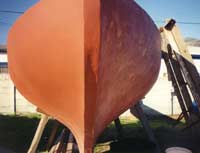 |
Look closely
at this picture,one half,the left,is re
primed after being hand sanded,the right
hand side still needs another coat of
primer.It worth noting that half of what
is applied ends up on the floor after
sanding it smooth. |
|
That Cup was presented to the yacht clubs of South
Africa on July 3rd 1907, being in the form of a letter
from Captain Sir Pieter Bam, then Vice Commodore RCYC
and enclosed was a cheque for some Two Hundred Pounds
Sterling, from Sir Thomas Lipton. Quite a tidy sum
in those days. The offer was recived by the then Commodore
of the RCYC Mr Maurice Goodall on behalf of all the
yacht clubs of South Africa. It was Sir Thomas Lipton's
way of raising the standards of sailing at the time.
Sir Thomas, a man who was rejected by the Royal Yacht
Squadron in Cowes, Isle of Wight, England. Due to
the simple fact he was a seen to be a lowly shop keeper
at the time! Memory tells me he then formed his own
yacht club and attempted to win The Americas Cup on
many occasions from that club. To this day the yacht
clubs of South Africa are still trying to win the
Lipton Cup and of course we can still buy Lipton Tea
world wide. Thomas was quite a clever ‘Shop
Keeper’ it seems.
Once Jean uttered her now famous words (they have
been published in SA Yachting magazine) I approached
FBYC to take over the boat. Gary Barker as project
manager/chairman for the boat asked that I request
this in writing, which I duly did by fax. Gary then
hand drafted a return letter on the 23rd May, 1997,
advising that the Friends of Astra Assocation (f.o.a)
met on the 9th, May 1997 and have agreed to your offer
to take over Astra. Ending with:
The committee have every confidence
that you will progress her restoration expeditiously
with no ulterior motive and they wish the very best
of luck in your undertaking.
| This is one
of Astra’s new owners, Trevour Howard,
between beers, I got them doing a really
great job of preparing Astra’s hull
for its next coat of paint. |
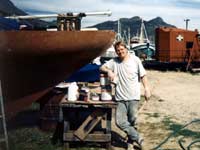
|
|
Given that they had already had a number of years
to repair the tired out old wreck, I was probably
going to need those kind words. I would also require
some help from my ‘home’ yacht club, the
Hout Bay Yacht Club, which is based in the harbour
in the village where we have lived for twenty odd
years.
To the Marina Committees credit and under the chair
of ex Hout Bay YC Commodore, Alan Batley, Astra was
indeed granted both a free hard standing space for
what turned out to be eighteen months while I did
the work. Then once launched a free marina berth as
well. Thank you HBYC.
So I now own a wreck! What next, one might ask? What
was being entrusted to me was a long way away from
where it was to be rebuilt. The trailer it sat on
was nothing more than a ‘Dolly’ to move
it around a flat boat park. So I now needed a good
road trailer but where would I find such a thing?
A tow truck I already had in my Ford LBW truck, that
had a 2.2 ltr engine and a tow hook already. I had
two things in my favour, one was an empty road trailer
in the HBYC boat park for an L 26 race yacht, the
other was given what Astras condition was in, it made
little difference what I did to her next, Which was
just as well.
Permission was sought and granted to use the empty
L26 road trailer. I then made a side view template
up from scrap ply of the stern of Astra. As it was
clear she would never front load on this kind of trailer.The
fit was near perfect, so a Navy crane was ordered
and we towed the trailer to the FBYC. On my request
Astra had now been taken back into the FBYC yard for
safe keeping. Loading was easy but supporting her
would not be so. The steel road trailer could not
be altered or marked in any way and its support arms
did not quite sit in the right places.
So with the help of Brad and Gary, we made a wood
cradle inside the steel one, this was through bolted
to Astras hull, I thought at the time Brad and Gary
were a little alarmed but knowing the long and hilly
roads we had to travel back to Hout Bay I had worked
this out long before. With plenty of pine timber planks
and handy threaded rod, washers and nuts I could easily
make up bolts to suit any requirement and so it was
that we finaly saw the whole contraption motor out
of the club's boat park and head for Hout Bay.
 |
By now
we were well on top of things,the rudder
has just been hung, launch date is close
to hand. |
|
Road traffic law in South Africa demands a back up
car when moving such loads. Brad did a fine job with
his Blue VW Beetle, traveling in convoy we soon reached
the top of Old Capse Weg, which is Afrikaans for 'Old
Cape Way', or road, we stopped to allow traffic that
had backed up pass and then continued down the mountain
pass to then reach our next target destination and
again stop, Constantia Nek or neck, a place where
three roads join up on the rise of a hill. Once again
we stopped to allow the traffic that had backed up
pass . Then it was just one more hill to decend and
we were entering Hout Bay.
| Brad, his
VW Beetle support car and Astra high up
on top of the Oue Kapse Wek road pass. |
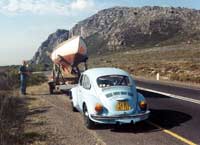
|
|
| 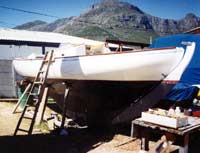 Arriving
at the HBYC boat yard was a welcome relief
but Brad an I had really enjoyed the trip,
it was still mid morning and we had found
the traffic both light and understanding
too. The rig was parked into the bay I
was to work in for the next year and a
half. We later used an overhead gantry
and block and tackle to remove the hulk
from the L26 trailer, which was quite
unharmed. Arriving
at the HBYC boat yard was a welcome relief
but Brad an I had really enjoyed the trip,
it was still mid morning and we had found
the traffic both light and understanding
too. The rig was parked into the bay I
was to work in for the next year and a
half. We later used an overhead gantry
and block and tackle to remove the hulk
from the L26 trailer, which was quite
unharmed.
|
|
| With mainly
the rudder and a few other fittings to bolt
onto the boat, we are very close to the
long travel to the water,just across the
way. |
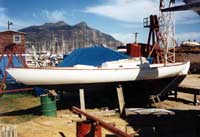
|
|
Now to assess what we needed to do, by ‘we’
I mean myself of course, as after an early offer by
some folk to help, nothing ever happened and to be
honest I can not blame them, this was a large undertaking.
After a quick Survey, it was clear that the decks
needed to be replaced, the cockpit was very none original,
it was also over weight and too large. But the Coach
roof was in rather good shape, a welcome bonus as
it gives the Tumlaren much of its character. So off
they all came, the cockpit became fire wood, the deck
beams saved where possible, the decks thrown away
but the coach roof was saved to be reused later in
the restoration.
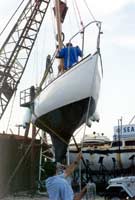 |
Launch
day, actually a day late and even when
we got the go ahead from the cranes owner,
Ken Evens, of the CIRCE LAUNCHES here
in Hout Bay, the crane then refused to
fire up at first. I think the combined
mass of people power thinking actually
started the crane that day.
To Ken Evens and
Oscar Walters, fellows who gave their
services for free to the Astra project,
Thanks guys!
|
|
I believe the Friends of Astra Association had every
intention of saving this boat but the work was just
too complicated and costly for the resources they
had. I also think they misunderstood the boat's construction.
As mentioned, the boat's hull is Carvel Planked. This
means the planks are shaped inside and out to fit
the frames, then fitted very close together and riveted
to the frames with bronze nails and roves. When a
plank is being hand crafted for one side, a second
is made at the same time, mirror fashion, to fit the
other side of the boat which should be exactly the
same. The whole construction was then bolted to a
steel frame set that bonded each side of the boat
to the other and then down to the Cast Lead Keel.
This made a very strong system with no caulked joints
at all.
The F.0.A in False Bay had either intended to repair
the planks or re-caulk the repairs. Which? I never
found out. If the planks had been back filled with
strips of new mahogany and epoxy glue, that would
have helped but the age of the wood was not going
to be of any help. In the ends of the boat, the unstressed
parts, the wood was like new but in the center where
all the cap shrouds terminated, the wood was soft.
The gaps in the planks in this area were some 9mm
wide (3/8”). This means caulking would not work
either. A friend told me later that he used to sail
the boat, and as they tacked jets of water would spurt
in through those planks! Things would settle down
a bit when sailing; just a few leaks.
| ‘People
Power’ moving the crane and Astra.
That’s Trevour Howard on the deck. |
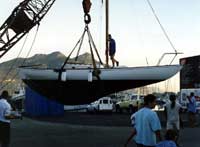
|
|
My idea was to preserve the boat once and for good,
no messing around. I was not going to do it twice
or ever again. To me this only means one thing: a
double diagonal cover of Marine ply and liberal application
of thin Epoxy to both bond the system together and
make the hull strong and light. This is where we have
to be objective. This method works as my pictures
show but if the boat is to Measure and race in its
class once more the boat can not be done this way.
The extra layers of plywood, two 4mm (3/16”)
will make the boat larger. It will float higher then
too. So if anyone contemplates restoration of a classic
yacht to still race, this must be understood first.
At this point it should be said that restoration
is a journey into the unknown. What you find as you
remove layer upon layer of old paint reveals the boat's
history. You can build a new boat faster too but then
it is a new boat and not the orginal classic we have
here today. As we stripped we found Copper Tingles
nailed on the outside to try and keep the water out.
We found putty forced into hull joints; what had been
Liquid Bitumin, hot poured into the bilge for the
same reason as the tingles. At some time the hull
had the starboard side damaged, as could be seen in
new planks in Meranti wood next the genuine Honduras
Mahogany originally used.
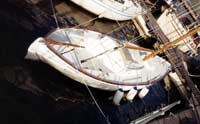 |
Finally
tied up in her berth on the Hout Bay YC
Marina.
|
|
A Special mention must be given to the Hout Bay Yacht
Club and its Marina Section. When the project was
brought to the boat park it was suggested that possibly
they could offer a spot for free. They not only agreed
to this, a period of some 18 months but when Astra
was launched they supplied a free marina berth as
well! Thank you to the Hout Bay YC.
The Knud Reimers
design ‘Tumlaren” Sail Number
8
Circa 1934. |
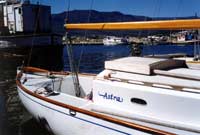
|
|
To say that this project was easy would be a lie.
It took a heck of a lot of my personal time. As mentioned
I was building ‘Flying Cloud’, a Dix 43
in wood/epoxy at the time. That boat was being fitted
out in the same boat yard as Astra. Any labour put
into saving Astra took those same hours off my own
build. But the commitment was made that for once I
would save a classic yacht, at least Astra was quite
a small sized boat. Scaffold was never used. This
is worth thinking about when contemplating such a
restoration yourself.
Will I do it again? For free, no, given a client's
open cheque book I may be tempted but it would have
to be in our own factory, not out in the open as this
was.
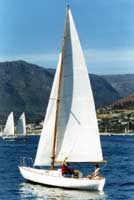 |
"Astra"
is now 72 years old and again winning
races.
|
|
June 25, 2006 Astra, is still owned by one of the
two partners who got involved with my restoration.
Oscar Walters now keeps his boat back in Simonstown,
False Bay and is a keen sailing member of the False
Bay YC.
To Astra and all who sail in her:
HAPPY SAILING!!
Roy Mc Bride founder www.ckdboats.com

Back to
Part 1...
 |
For more
about the Tumlaren design, click the image
at left.
|
|

|